Table of Contents
Why We Need Advertisement?
Advertising is a powerful communication force, highly visible, and one of the most important tools of marketing communications that help to sell products, services, ideas, and images, etc. Many believe that advertising reflects the needs of the times.
Table of Contents
One may like it or not but advertisements are everywhere. Advertisements are seen in newspapers, magazines, on television, and on the internet and are heard on the radio. The average consumer is exposed to a very large number of advertisements every day, particularly the urban and semi-urban population.
Role of Advertising
The role of advertising can be classified into two categories:
Role of Advertising in Marketing Mix
The marketing mix is the combination of elements necessary to the planning and execution of the total marketing operation. The ‘Four Ps’ concept of the marketing mix, developed by Philip Kotler, and widely adopted by marketing teachers, create four divisions of the mix, namely, product, price, promotion, and place.
Advertising is an element of promotion. However, it not only assists in promoting the product but also affects the other variables of the marketing mix. This can be explained as follows:
- Product Advertising
- Advertising Price
- Advertising Place
- Advertising and Promotion
- Pace Advertising
- Packaging and Advertising
- Advertising Positioning
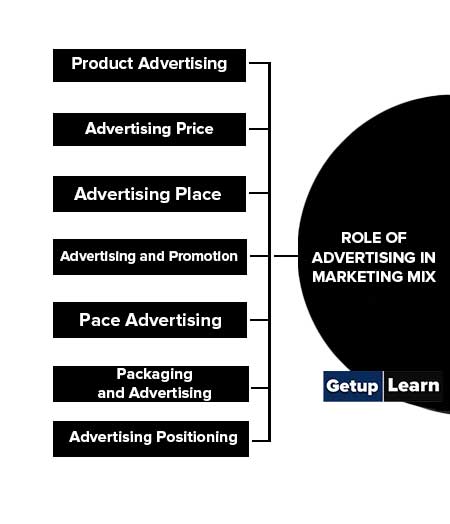
Product Advertising
A product is normally a set of physical elements, such as quality, shape, size, color, and other features. The product may be of very high quality. At times, the product is so designed that it requires careful handling and operations.
Buyers must be informed and educated on the various aspects of the product. This can be effectively done through advertising. Thus, advertising plays the role of information and education.
Advertising Price
The price is the exchange value of the product. A marketer may bring out a very high-quality product with additional features as compared to competitors. In such a case, the price would be definitely high. But buyers may not be willing to pay a high price would be definitely high.
Here comes advertising. Advertising can convince buyers regarding the superiority of the brand and thus its value for money.
This can be done by associating the product with prestigious people, situations, or events. Alternatively when a firm offers low price products the job of advertising needs to stress the price advantage by using hard-hitting copy.
It is not just enough to convince, but it is desirable to persuade the buyer. Thus advertising plays the role of conviction and persuasion.
Advertising Place
Place refers to physical distribution and the stores where the goods are available Marketers should see to it that the goods are available at a convenient place and that too at the right time when the buyers need it.
To facilitate effective distribution and expansion of the market, advertising is of great significance. Thus advertising does help in effective distribution and market expansion.
Advertising and Promotion
Promotion consists of advertising, publicity, personal selling, and sales promotion techniques. Businessmen today have to face a lot of competition. Every seller needs effective promotion to survive and succeed in this competitive business world.
Advertising can play a significant role to put forward the claim of the seller, and countering the claims of competitors. Through effective advertising, sellers can face competition and also help to develop brand image and brand loyalty.
Pace Advertising
Pace refers to the speed in marketing decisions and actions. It involves among other things the launch of new products or brand variations at a greater speed than before. As and when new brands are launched, advertising plays an important role in informing, educating, and persuading the customers to buy the product.
Packaging and Advertising
The main purpose of packaging is the protection of the product during transit and the preservation of quality and quantity. Nowadays, marketers take a lot of effort to develop and design attractive packages as they carry advertising value.
A creative design package attracts the attention of the customers. It also carries an assurance of quality and creates confidence in the minds of customers to buy the product.
Advertising Positioning
Product positioning aims at creating and maintaining a distinct image of the brands in the minds of the customers. Through advertising, the marketer can convey the positioning of the brand and accordingly can influence the buying decision of the target audience.
Role of Advertising in Society
Advertising is an integral part of everyday life. It is a pervasive method of marketing in society. Though the methods by which marketers advertise have changed over the decades, the role and purpose of advertising have changed over the period of time.
Without advertising modern society cannot survive. Advertising is useful to society in the following ways. The following are roles of advertising in society:
- Encourage Purchasing
- Reflect Cultural Trends
- Promotes Economic Growth
- Improves Standard of Living
- Provides employment
- Advertising and Brand building

Encourage Purchasing
Encouraging people to purchase goods and services is the main role of advertising. Some industries rely on advertising more than others: A cereal company, for instance, must advertise more aggressively, due to the wide arrange of competing products, than a power company that faces little to no competition.
Advertisers often influence members of society to purchase products based on instilling a feeling of scarcity or lack.
Reflect Cultural Trends
Advertising bridges the gap among people by communicating varied cultures through advertising messages. It brings variation to social life.
Promotes Economic Growth
Advertising contributes to bringing about all-around development of the economy by increasing demand and by encouraging economic activities it fuels the desire to shop and, in turn, shopping stimulates the economy.
Improves Standard of Living
Advertising is an economic activity. It provides opportunities for people to improve their income. It motivates people to consume more material and thereby improves their standard of living.
Provides employment
Effective advertising generates demand for goods and services. high demand calls for more production which requires more physical and human resources thus creating employment opportunities.
Advertising and Brand building
Brands are the identification that differentiates one business from another (through name, symbol, etc.). However, today brands can also be defined as the personality they reflect people in relation to status, emotional characteristics, and subjective quality.
They give the consumers a perceived knowledge of the product, its quality, and uniqueness before they buy it. Brands Ensure delivery of service as promised by them.
For example, Pizza Company A claims to deliver pizza within a certain time and Pizza Company B claims to deliver the most delicious Pizzas. It makes it easy for the consumers to identify what they want and which brand to choose for it. It is important for a brand to accomplish the claim advertised to retain its Brand Image.
Characteristics of Advertising
These are characteristics of advertising which are given below:
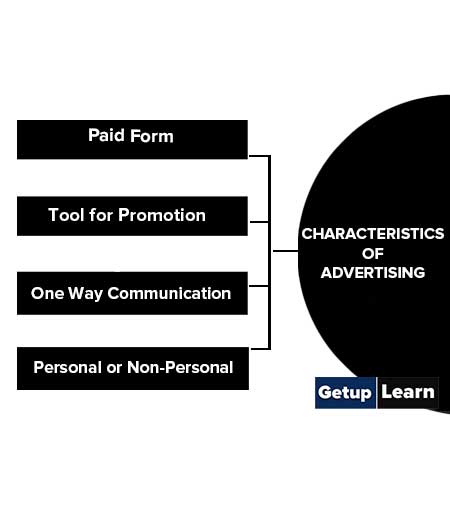
Paid Form
Advertising requires the advertiser (also called the sponsor) to pay to create an advertising message, to buy advertising media slots, and monitor advertising efforts.
Tool for Promotion
Advertising is an element of the promotion mix of an organization.
One Way Communication
Advertising is a one-way communication where a brand communicates to the customers through different mediums.
Personal or Non-Personal
Advertising can be non-personal as in the case of TV, radio, or newspaper advertisements, or highly personal as in the case of social media and other cookie-based advertisements.
Advantages of Advertising
These are advantages of advertising let’s discuss them:
- Reduces Per Unit Cost
- Helps in Brand Building
- Helps in Launching New Product
- Boosts up Existing Customers
- Helps in Reducing Customer Turnover
- Attracts New Customers
- Educates the Customers
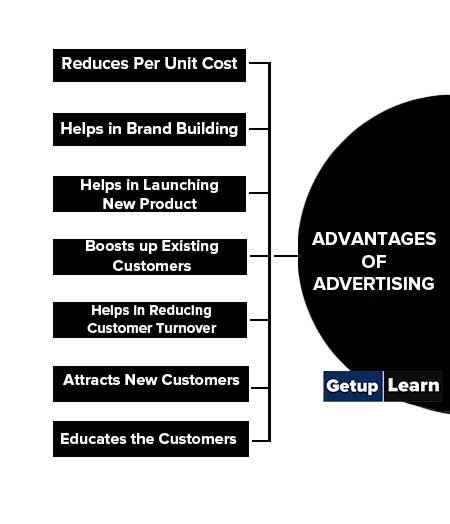
Reduces Per Unit Cost
The wide appeal of advertisements increases the demand for the product which benefits the organization as it capitalizes on the economies of scale.
Helps in Brand Building
Advertisements work effectively in brand building. Brands that advertise are preferred over those which don’t.
Helps in Launching New Product
Launching a new product is easy when it is backed by an advertisement.
Boosts up Existing Customers
Boosts up Existing Customers’ Confidence in the Brand: Advertisements boost up existing customers’ confidence in the brand as they get a feeling of pride when they see an advertisement of the product or the brand they use.
Helps in Reducing Customer Turnover
A strategic advertisement of new offers and better service helps reduce customer turnover.
Attracts New Customers
An attractive advertisement helps the brand in gaining new customers and expanding business.
Educates the Customers
Advertisements inform the customers about different products existing in the market and also educates them in what they should look for in an apt product.
Disadvantages of Advertising
These are disadvantages of advertising let’s discuss them:
- Increases the Costs
- Confuses the Buyer
- Is Sometimes Misleading
- Only For Big Businesses
- Encourages the Sale of Inferior Products
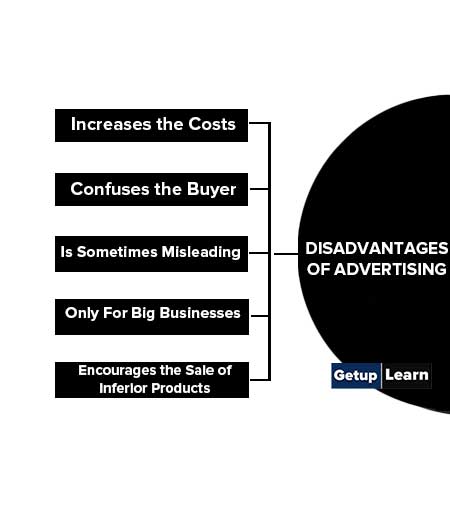
Increases the Costs
Advertising is an expense to the business and is added to the cost of the product. This cost is eventually borne by the end consumer.
Confuses the Buyer
Too many advertisements with similar claims often confuses the buyer in what to buy and should he buy the product or not.
Is Sometimes Misleading
Some advertisements use smart strategies to mislead customers.
Only For Big Businesses
Advertising is a costly affair and only big businesses can afford it. This makes small businesses out of competition with big businesses that gets to enjoy a monopoly in the market.
Encourages the Sale of Inferior Products
Effective advertisements even lead to the sale of inferior products which aren’t good for the consumers.
Negative Effects of Advertising
Advertising has both positive and negative effects. The undesirable consequences of advertising are generally termed dysfunctions.
Following are some of the negative effects of advertising:
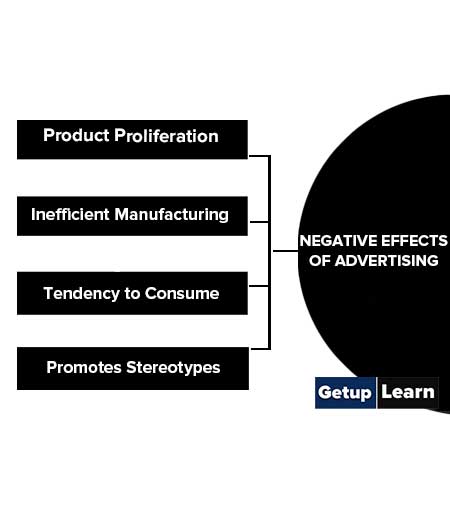
Product Proliferation
The effect of advertising encourages the proliferation of unnecessary products. The multiplication of identical products may result in the wastage of resources that could otherwise have been used more productively. For example, android technology has made smartphones highly affordable.
Many people have bought smartphones leaving their old phones aside. The old phones constitute a heap of hazardous e-waste.
Inefficient Manufacturing
Cut-throat competition has several impacts. When a competitor slashes the price of a product, other producers are compelled to reduce prices. The cost-cutting measures will lead to a compromise in quality. Such aggressive campaigns may help the companies to stay in the business.
But it is damaging to the consumers if they buy low-quality products as a result of such advertising.
Tendency to Consume
It is believed that advertising raises the tendency to consume more than what is desirable in developing nations. Consumerism is a situation where people buy things even when they are of limited use to them. A developing country cannot afford the high propensity to consume like the industrialized nations.
Promotes Stereotypes
Advertising promotes stereotypes by depicting certain groups or individuals in stereotyped roles. Women are usually portrayed as housewives or mothers and thus apparently relegating them to a secondary role.
What are roles of advertising?
Advertising is a powerful communication force, highly visible, and one of the most important tools of marketing communications that help to sell products, services, ideas, and images, etc. Many believe that advertising reflects the needs of the times.
What are the 5 functions of advertising?
The major functions of advertising are that it:
1. Informs
2. Educates
3. Creates Demand
4. Enhances Competition
5. Establishes Brand Identity
6. Promotes Action
7. Improves Customer Base.
What is marketing mix in advertising?
The marketing mix is the combination of elements necessary to the planning and execution of the total marketing operation. The ‘Four Ps’ concept of the marketing mix, developed by Philip Kotler, and widely adopted by marketing teachers, create four divisions of the mix, namely, product, price, promotion, and place.
What is the role of advertising in society?
Without advertising modern society cannot survive. Advertising is useful to society in the following ways:
1. Encourage Purchasing
2. Reflect Cultural Trends
3. Promotes Economic Growth
4. Improves Standard of Living
5. Provides employment
6. Advertising and Brand building.
What are positive and negative effects of advertising?
Positive effects are: 1. Reduces Per Unit Cost, 2. Helps in Brand Building, 3. Helps in Launching New Product, 4. Boosts up Existing Customers, 5. Helps in Reducing Customer Turnover, 6. Attracts New Customers, 7. Educates the Customers.
Negetive effects are: 1. Product Proliferation, 2. Inefficient Manufacturing, 3. Tendency to Consume, 4. Promotes Stereotypes.
